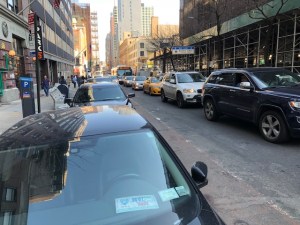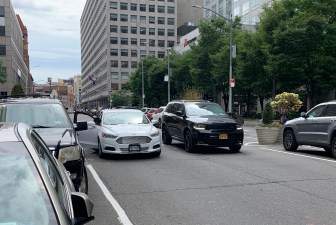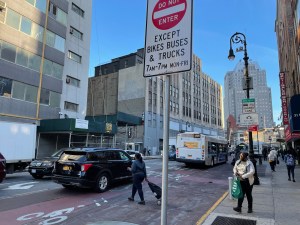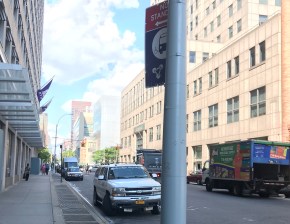Eyes on the Street: The Jay Street Busway is Being Undermined by Illegal Car Traffic

This busway needs a rescue plan.
One year after the Jay Street Busway was working as designed, boosting bus speeds for almost 50,000 daily riders along the Downtown Brooklyn corridor, commutes for long-suffering bus riders are slowing as more drivers flout the basic rule, “No cars allowed.”
That rule has not changed since the busway was implemented: Only buses and trucks can enter the road at Smith Street and Livingston Street heading north and at Jay Street and Tillary Street heading south. Any cars entering the road elsewhere along its .4-mile route have to turn off at the first available opportunity. There are other opportunities to enter the busway at Willoughby Street, MetroTech Roadway and Johnson Street, which makes it porous for such a short stretch of roadway.
Buses are faster than before the busway existed, but the city’s slow return to normalcy (i.e. car driving) has cut into the gains. But according to data shared by Department of Transportation to the busway’s Community Asvisory Board in October, northbound buses on Jay Street have suffered the most when comparing September 2020 to September 2021, as every gain has been chipped away:
- Morning rush hour buses have dropped from 6.5 miles per hour to 5.5 miles per hour.
- Midday buses have dropped from almost 6 miles per hour to just over 4 miles per hour.
- Evening rush hour buses have dropped from just over 6 miles per hour to just over 5 miles per hour.
Southbound buses have not slowed during the morning and evening rush hours, but afternoon buses have dropped in speed from just over 6 miles per hour in September 2020 to about 4.5 miles per hour in September 2021.
Buses are moving faster than pre-busway days on Jay Street, with no bus moving faster than 5 miles per hour before the busway was instituted, but that’s an accomplishment on par with the Jets going from 4-12 to 7-9 from one season to the next.
Those northbound buses are suffering for what looks like a pretty simple reason: More people are just ignoring the big DO NOT ENTER sign at the entrance to the busway on Smith Street and Livingston Street. The city’s own data shows that combined north-south car traffic, which the agency said it counted between Johnson Street and MetroTech Plaza has hit over 150 vehicles per hour during the morning and evening rush hours, after falling to just over 50 and 100 vehicles per hour respectively last September. And some recent busway observations backed up the data.
On a recent Thursday morning before 9 a.m., 14 cars entered the busway heading north from Smith and Livingston in just five minutes of observation. On Wednesday morning at the same spot, it was eight car drivers deciding to ignore the rules. On Tuesday afternoon, eight car drivers got onto the busway in just five minutes, including three who turned from Livingston onto Smith. As a result, bus riders — for whom the busway was built — say they’re still getting stuck in traffic.
“Yes, it does get stuck in traffic,” a B62 rider named Ann told Streetsblog. “We have a lot of traffic on this road.”
For southbound traffic, although many drivers didn’t illegally access Jay Street by continuing to drive on the block across Tillary, a handful were observed headed south by using the left turn lane on Tillary marked with red paint that is only supposed to be used by buses and trucks.
Drivers who illegally get on the busway at Livingston Street are also not making turns off the busway at their first right turn, as required. In five minutes of observation on Tuesday afternoon, 10 out of 12 northbound drivers drove past the first right turn into the MetroTech passage. An additional driver who left the busway was seen angrily driving the wrong way down the street to make a turn around the car in front of them, almost hitting a cyclist crossing with the light.
The placard abuse on the block can also verge on parody. On Tuesday afternoon the entire southbound stretch of Jay Street from the abrupt end of the protected bike lane at the MetroTech passage to corner of Willoughby Street, which is marked as a No Standing zone so that buses can pull to the curb, was nothing but parked cars with NYPD placards. One of the cars may as well have belonged to the crown prince of crime himself: a car with an NYPD placard and the plate ICLOWN4U, which has racked up 40 tickets since 2013, including 10 speeding tickets since April 2020. The NYPD did not respond to a request for comment regarding the placard abuse.
The flagrant rule-flouting left rider advocates frustrated and stating the obvious: this thing doesn’t work if the rules are optional.
“Busways only work for riders if restrictions are enforced against drivers,” said Riders Alliance Policy and Communications Director Danny Pearlstein. “At the same time, some restrictions are more easily enforced. Watering down the rules to appease drivers may ultimately help no one.”
The only defense against busway incursions right now are signage and fixed cameras, which according to the CAB presentation are placed at Smith Street and Fulton Street to nab northbound violators and placed at Jay Street and Johnson Street to get drivers who are moving southbound. Data shared with the CAB showed that the cameras caught cars going south than the ones going north every day each month from March to August, except in April, including a high of almost 50 per day in June 2021. To improve the camera capabilities, the agency has issued what it called “more explicit guidelines for Automated Enforcement staff assigned to Jay St.” in an effort to catch more bus lane violators.
The DOT said that it’s planning on installing a new overhead sign on Smith Street between Schermerhorn Street and Livingston Street informing car drivers they don’t belong there, and that on-board bus lane enforcement cameras were coming to buses that used the route. In August, the MTA announced that it was installing 300 more cameras on buses systemwide in 2022 and 600 in buses by 2023.
A spokesperson for the DOT did not say if the agency would ask the NYPD to deploy additional Traffic Enforcement Agents to inform drivers returning to the area that things have changed while they were gone. And the agency declined to comment specifically on the reductions in speeds for buses along the supposed bus priority corridor.
Instead, agency spokesperson Alana Morales said that ” continued automated enforcement and additional signage over time will discourage improper use of the busway.”




